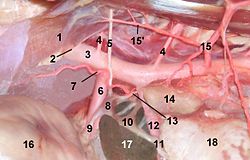Celiac ganglia
| Celiac ganglia | |
|---|---|

|
|

Celiac and cranial mesenteric ganglion in a cat. 1 Crus sinistrum (Diaphragma), 2 hiatus aorticus, 3 Aorta, 4 Arteria lumbalis, 5 Nervus splanchnicus major, 6 Arteria coeliaca, 7 Arteria phrenica caudalis, 8 Celiac ganglion, 9 Plexus coeliacus, 10 Ganglion mesentericum craniale, 11 Plexus mesentericus cranialis, 12 Arteria mesenterica cranialis, 13 Nervus splanchnicus minor, 14 Adrenal gland, 15 Arteria abdominalis cranialis, 16 Stomach, 17 Liver (Lobus caudatus), 18 Kidney
|
|
| Details | |
| From | thoracic splanchnic nerves |
| Identifiers | |
| Latin | Ganglia coeliaca |
| MeSH | A08.340.315.350 |
| Dorlands /Elsevier |
g_02/12384424 |
| TA | A14.3.03.027 |
| FMA | 77584 |
|
Anatomical terms of neuroanatomy
[]
|
|
The celiac ganglia or coeliac ganglia are two large irregularly shaped masses of nerve tissue in the upper abdomen. Part of the sympathetic subdivision of the autonomic nervous system (ANS), the two celiac ganglia are the largest ganglia in the ANS, and they innervate most of the digestive tract.
They have the appearance of lymph glands and are placed on either side of the midline in front of the crura of the diaphragm, close to the suprarenal glands (also called adrenal glands). The ganglion on the right side is placed behind the inferior vena cava.
They are sometimes referred to as the semilunar ganglia or the solar ganglia.
The celiac ganglion is part of the sympathetic prevertebral chain possessing a great variety of specific receptors and neurotransmitters such as catecholamines, neuropeptides, and nitric oxide and constitutes a modulation center in the pathway of the afferent and efferent fibers between the central nervous system and the ovary.
The main preganglion neurotransmitter of the celiac ganglion is acetylcholine, yet the celiac ganglion-mesenteric complex also contain α and β adrenergic receptors and is innervated by fibers of adrenergic nature that come from other preaortic ganglia.
The upper part of each ganglion is joined by the greater splanchnic nerve, while the lower part, which is segmented off and named the aorticorenal ganglion, receives the lesser splanchnic nerve and gives off the greater part of the renal plexus.
...
Wikipedia
